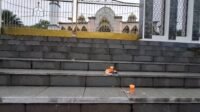BANGKA BARAT,PERKARANEWS – Akibat narkotika, pria ini diringkus Polsek Mentok, Polres Bangka Barat. AN (35) laki laki wiraswasta dan SY (38) laki laki wiraswasta, merupakan pelaku penyalahgunaan narkoba yang diringkus Polsek Mentok, Selasa (16/1/2024).
Kapolres Bangka Barat, AKBP Ade Zamrah SIK melalui Kasat Resnarkoba, Iptu Budi Prasetyo menjelaskan kronologis kejadian.
Pada hari Kamis tanggal 11 Januari 2025 Unit Res Intel Polsek Mentok mendapatkan informasi dari masayarakat bahwa adanya penyalahgunaan narkoba di kontrakan (AN) yang beralamat di Kp. Tegal Rejo, Kel. Sungai Baru, Kec. Mentok. Kemudian Unit Res Intel Polsek Mentok melakukan penyelidikan terhadap penyalahgunaan narkotika tersebut.

“Berdasarkan informasi tersebut sekitar pukul 19.00 WIB Unit Res Intel Polsek Mentok mengamankan 2 (Dua) orang laki-laki berinisial (AN), dan (SY) dikontrakan milik (AN) Kp. Tegal Rejo, Kel. Sungai Baru, Kec. Mentok,” ungkapnya.
Pada saat anggota melakukan penggeledahan yang disaksikan oleh Staf Lurah Sungai Baru ditemukan 10 (Sepuluh) paket plastik klip bening yang berisikan butiran kristal putih yang diduga narkotika jenis sabu-sabu yang diantaranya; 9 (Sembilan) paket narkotika jenis sabu-sabu ditemukan dibawah meja ruang tamu yang disimpan dalam kotak plastik warna hitam dan dibalut dengan lakban warna hitam, dan 1 (paket) didalam kamar kontrakan tepat nya diatas speaker pelaku serta dua buah bong atau alat hisap.
“Kedua pelaku beserta barang bukti diamankan dan dibawa ke Mapolsek Mentok guna penyidikan lebih lanjut,” jelasnya.

Adapun barang bukti yang diamankan 10 (Sepuluh) buah plastik klip berukuran kecil yang berisi kristal bening narkotika jenis sabu-sabu ( Brutto 1,71 gram), 1 (Satu) buah plastik klip kosong berukuran sedang,1 (satu) unit timbangan digital merk camry warna hitam, 1 (Satu) ball plastik klip bening kosong, 1 (Satu) unit handphone android merk vivo warna hitam, 1 (Satu) unit handphone merk nokia blacksenter warna hitam, 2 (Dua) buah alat hisap narkotika jenis sabu/ bong, 1 (Satu) buah kotak kecil yang di balut lakban warna hitam. (Yuko)
















More Bonuses Best solana wallet
Профессиональное https://kosmetologicheskoe-oborudovanie-msk.ru для салонов красоты, клиник и частных мастеров. Аппараты для чистки, омоложения, лазерной эпиляции, лифтинга и ухода за кожей.
Tree-covered mountains rise behind a pile of trash, children run through the orange haze of a dust storm, and a billboard standing on parched earth indicates where the seashore used to be before desertification took hold. These striking images, exhibited as part of the Right Here, Right Now Global Climate Summit, show the devastating effects of climate change.
kra34.cc
The summit, held at the University of Oxford in the UK and supported by UN Human Rights (OHCHR), aims to reframe climate change as a human rights crisis and spotlight climate solutions. It works with everyone from policymakers to artists to get the message across.
“Photographers document the human rights impacts of climate change, helping to inform the public and hold governments and businesses accountable,” said Volker Turk, UN High Commissioner for the OHCHR, via email. “The Right Here, Right Now Global Climate Summit shows the power of collective action — uniting storytellers, scientists, indigenous leaders, and others to advance climate solutions rooted in human rights.”
Coinciding with World Environment Day on June 5, the exhibition — titled “Photography 4 Humanity: A Lens on Climate Justice” — features the work of 31 photographers from across the globe, all documenting the effects of global warming and environmental pollution on their own communities.
Climate change disproportionately affects vulnerable populations around the world. Despite emitting far fewer greenhouse gases, low-income nations are suffering the most from extreme weather events and have fewer resources to adapt or recover.
Photographs at the exhibition show the effects of desertification, flooding and plastic pollution. A black and white image shows the ruins of a house in West Bengal, India, sloping towards the Ganges River, with the owner sitting alongside. Riverbank erosion is degrading the environment and displacing communities in the area. Photographer Masood Sarwer said in a press release that the photo depicts the “slow violence” of climate change: “These are not sudden disasters, but slow-moving, relentless ones — shaping a new category of environmental refugees.”
Another photo, taken by Aung Chan Thar, shows children fishing for trash in Inle Lake, Myanmar. The lake was once a pristine natural wonder but now faces the growing threat of plastic pollution. “This image of children cleaning the water symbolizes the importance of education and collective action in preserving our environment for a sustainable future,” he said.
Organizers hope that the exhibition will help to humanize the climate crisis. “Our mission is to inspire new perspectives through photography,” said Pauline Benthede, global vice president of artistic direction and exhibitions at Fotografiska, the museum of photography, art and culture that is curating the exhibition at the summit. “It draws attention to the human rights issue at the heart of global warming, which affects both the world’s landscapes and the people that live within them.”
“Photography is the most influential and inclusive art form of our times and has the power to foster understanding and inspire action,” she added.
¡Hola, fanáticos de las apuestas!
Casinofueradeespanol incluye tutoriales interactivos para cada categorГa de juego. AsГ aprendes directamente desde la plataforma. Ideal para quienes se inician en el mundo del juego online.
Casino por fuera ofrece soporte multilingГјe, incluyendo espaГ±ol, disponible todo el dГa. п»їcasino fuera de espaГ±a Esto facilita la comunicaciГіn con el equipo tГ©cnico. Te sentirГЎs respaldado en cada momento.
Casinos fuera de EspaГ±a con mГ©todos de pago anГіnimos – п»їhttps://casinofueradeespanol.xyz/
¡Que experimentes éxitos notables !
Tree-covered mountains rise behind a pile of trash, children run through the orange haze of a dust storm, and a billboard standing on parched earth indicates where the seashore used to be before desertification took hold. These striking images, exhibited as part of the Right Here, Right Now Global Climate Summit, show the devastating effects of climate change.
kraken tor
The summit, held at the University of Oxford in the UK and supported by UN Human Rights (OHCHR), aims to reframe climate change as a human rights crisis and spotlight climate solutions. It works with everyone from policymakers to artists to get the message across.
“Photographers document the human rights impacts of climate change, helping to inform the public and hold governments and businesses accountable,” said Volker Turk, UN High Commissioner for the OHCHR, via email. “The Right Here, Right Now Global Climate Summit shows the power of collective action — uniting storytellers, scientists, indigenous leaders, and others to advance climate solutions rooted in human rights.”
Coinciding with World Environment Day on June 5, the exhibition — titled “Photography 4 Humanity: A Lens on Climate Justice” — features the work of 31 photographers from across the globe, all documenting the effects of global warming and environmental pollution on their own communities.
Climate change disproportionately affects vulnerable populations around the world. Despite emitting far fewer greenhouse gases, low-income nations are suffering the most from extreme weather events and have fewer resources to adapt or recover.
Photographs at the exhibition show the effects of desertification, flooding and plastic pollution. A black and white image shows the ruins of a house in West Bengal, India, sloping towards the Ganges River, with the owner sitting alongside. Riverbank erosion is degrading the environment and displacing communities in the area. Photographer Masood Sarwer said in a press release that the photo depicts the “slow violence” of climate change: “These are not sudden disasters, but slow-moving, relentless ones — shaping a new category of environmental refugees.”
Another photo, taken by Aung Chan Thar, shows children fishing for trash in Inle Lake, Myanmar. The lake was once a pristine natural wonder but now faces the growing threat of plastic pollution. “This image of children cleaning the water symbolizes the importance of education and collective action in preserving our environment for a sustainable future,” he said.
Organizers hope that the exhibition will help to humanize the climate crisis. “Our mission is to inspire new perspectives through photography,” said Pauline Benthede, global vice president of artistic direction and exhibitions at Fotografiska, the museum of photography, art and culture that is curating the exhibition at the summit. “It draws attention to the human rights issue at the heart of global warming, which affects both the world’s landscapes and the people that live within them.”
“Photography is the most influential and inclusive art form of our times and has the power to foster understanding and inspire action,” she added.
Scientists mapped what happens if a crucial system of ocean currents collapses. The weather impact would be extreme
пин ап сайт
The collapse of a crucial network of Atlantic Ocean currents could push parts of the world into a deep freeze, with winter temperatures plunging to around minus 55 degrees Fahrenheit in some cities, bringing “profound climate and societal impacts,” according to a new study.
There is increasing concern about the future of the Atlantic Meridional Overturning Circulation — known as the AMOC — a system of currents that works like a giant conveyor belt, pulling warm water from the Southern Hemisphere and tropics to the Northern Hemisphere, where it cools, sinks and flows back south.
Multiple studies suggest the AMOC is weakening with some projecting it could even collapse this century as global warming disrupts the balance of heat and salinity that keeps it moving. This would usher in huge global weather and climate shifts — including plunging temperatures in Europe, which relies on the AMOC for its mild climate.
What’s less clear, however, is how these impacts will unfold in a world heated up by humans burning fossil fuels.
“What if the AMOC collapses and we have climate change? Does the cooling win or does the warming win?” asked Rene van Westen, a marine and atmospheric researcher at Utrecht University in the Netherlands and co-author of the paper published Wednesday in the Geophysical Research Letters journal.
This new study is the first to use a modern, complex climate model to answer the question, he told CNN.
The researchers looked at a scenario where the AMOC weakens by 80% and the Earth is around 2 degrees Celsius warmer than the period before humans began burning large amounts of fossil fuels. The planet is currently at 1.2 degrees of warming.
They focused on what would happen as the climate stabilized post-collapse, multiple decades into the future.
Even in this hotter world, they found “substantial cooling” over Europe with sharp drops in average winter temperatures and more intense cold extremes — a very different picture than the United States, where the study found temperatures would continue to increase even with an AMOC collapse.
Sea ice would spread southward as far as Scandinavia, parts of the United Kingdom and the Netherlands, the research found. This would have a huge impact on cold extremes as the white surface of the ice reflects the sun’s energy back into space, amplifying cooling.
The scientists have created an interactive map to visualize the impacts of an AMOC collapse across the globe.
Сервисный центр предлагает ремонт квадрокоптера carrera в челябинске качественый ремонт квадрокоптера carrera
¡Hola, aficionados a las apuestas!
La web casinosextranjerosespana.es recopila las mejores opciones internacionales disponibles desde EspaГ±a. AquГ puedes comparar bonos, juegos y mГ©todos de pago sin necesidad de registro. Todo estГЎ enfocado en ayudarte a jugar sin lГmites.
ВїBuscas juegos Гєnicos y de alta volatilidad? En los mejores casinos online extranjeros como casinosextranjerosespana.es los encontrarГЎs fГЎcilmente.
Bonos exclusivos en casinoextranjeros.es sin verificaciГіn – п»їhttps://casinoextranjeros.es/
¡Que vivas jugadas brillantes !
Сервисный центр предлагает ремонт индукционных плит gorenje рядом ремонт индукционной плиты gorenje в челябинске
svt-stroy.ru – Все о стройке и ремонте.
Разбираем подробно – Чем отделать фасад дома из газобетона в нашем строительном блоге.
Советы опытных специалистов, дизайнеров и инженеров! Ремонтируйте свой загородный дом с умом!
Сервисный центр предлагает ремонт планшетов lexand качественный ремонт планшетов lexand
Hi! Do you know if they make any plugins to safeguard against hackers? I’m kinda paranoid about losing everything I’ve worked hard on. Any recommendations?
hafilat darb.ae
NASA scientists are in a state of anxious limbo after the Trump administration proposed a budget that would eliminate one of the United States’ top climate labs – the NASA Goddard Institute for Space Studies, or GISS – as a standalone entity.
kra34.cc
In its place, it would move some of the lab’s functions into a broader environmental modeling effort across the agency.
Career specialists are now working remotely, awaiting details and even more unsure about their future at the lab after they were kicked out of their longtime home in New York City last week. Closing the lab for good could jeopardize its value and the country’s leadership role in global climate science, sources say.
“It’s an absolute sh*tshow,” one GISS scientist said under condition of anonymity because they were not authorized to speak to the media. “Morale at GISS has never been lower, and it feels for all of us that we are being abandoned by NASA leadership.”
“We are supposedly going to be integrated into this new virtual NASA modeling institute, but (we have) no idea what that will actually look like,” they said.
NASA is defending its budget proposal, with a nod toward the lab’s future.
“NASA’s GISS has a significant place in the history of space science and its work is critical for the Earth Science Division, particularly as the division looks to the future of its modeling work and capabilities,” NASA spokesperson Cheryl Warner said in a statement.
“Fundamental contributions in research and applications from GISS directly impact daily life by showing the Earth system connections that impact the air we breathe, our health, the food we grow, and the cities we live in,” Warner said.
GISS has a storied history in climate science on the global scale.
James Hansen, a former director, first called national attention to human-caused global warming at a Senate hearing during the hot summer of 1988. The lab, founded in 1961, is still known worldwide for its computer modeling of the planet that enable scientists to make projections for how climate change may affect global temperatures, precipitation, extreme weather events and other variables.
¡Saludos, buscadores de fortuna !
Los mejores casinos sin licencia en EspaГ±a tienen programas VIP con recompensas reales. Desde bonos personalizados hasta asistencia exclusiva, la experiencia es premium. Es un incentivo fuerte para los jugadores frecuentes.
Los casinos online sin licencia permiten realizar apuestas sin establecer lГmites mГЎximos.
Casino online sin licencia: ventajas frente a casinos regulados – п»їcasinos-sinlicenciaenespana.es
¡Que vivas botes increíbles!
NASA scientists are in a state of anxious limbo after the Trump administration proposed a budget that would eliminate one of the United States’ top climate labs – the NASA Goddard Institute for Space Studies, or GISS – as a standalone entity.
kra35.cc
In its place, it would move some of the lab’s functions into a broader environmental modeling effort across the agency.
Career specialists are now working remotely, awaiting details and even more unsure about their future at the lab after they were kicked out of their longtime home in New York City last week. Closing the lab for good could jeopardize its value and the country’s leadership role in global climate science, sources say.
“It’s an absolute sh*tshow,” one GISS scientist said under condition of anonymity because they were not authorized to speak to the media. “Morale at GISS has never been lower, and it feels for all of us that we are being abandoned by NASA leadership.”
“We are supposedly going to be integrated into this new virtual NASA modeling institute, but (we have) no idea what that will actually look like,” they said.
NASA is defending its budget proposal, with a nod toward the lab’s future.
“NASA’s GISS has a significant place in the history of space science and its work is critical for the Earth Science Division, particularly as the division looks to the future of its modeling work and capabilities,” NASA spokesperson Cheryl Warner said in a statement.
“Fundamental contributions in research and applications from GISS directly impact daily life by showing the Earth system connections that impact the air we breathe, our health, the food we grow, and the cities we live in,” Warner said.
GISS has a storied history in climate science on the global scale.
James Hansen, a former director, first called national attention to human-caused global warming at a Senate hearing during the hot summer of 1988. The lab, founded in 1961, is still known worldwide for its computer modeling of the planet that enable scientists to make projections for how climate change may affect global temperatures, precipitation, extreme weather events and other variables.
NASA scientists are in a state of anxious limbo after the Trump administration proposed a budget that would eliminate one of the United States’ top climate labs – the NASA Goddard Institute for Space Studies, or GISS – as a standalone entity.
kra35cc
In its place, it would move some of the lab’s functions into a broader environmental modeling effort across the agency.
Career specialists are now working remotely, awaiting details and even more unsure about their future at the lab after they were kicked out of their longtime home in New York City last week. Closing the lab for good could jeopardize its value and the country’s leadership role in global climate science, sources say.
“It’s an absolute sh*tshow,” one GISS scientist said under condition of anonymity because they were not authorized to speak to the media. “Morale at GISS has never been lower, and it feels for all of us that we are being abandoned by NASA leadership.”
“We are supposedly going to be integrated into this new virtual NASA modeling institute, but (we have) no idea what that will actually look like,” they said.
NASA is defending its budget proposal, with a nod toward the lab’s future.
“NASA’s GISS has a significant place in the history of space science and its work is critical for the Earth Science Division, particularly as the division looks to the future of its modeling work and capabilities,” NASA spokesperson Cheryl Warner said in a statement.
“Fundamental contributions in research and applications from GISS directly impact daily life by showing the Earth system connections that impact the air we breathe, our health, the food we grow, and the cities we live in,” Warner said.
GISS has a storied history in climate science on the global scale.
James Hansen, a former director, first called national attention to human-caused global warming at a Senate hearing during the hot summer of 1988. The lab, founded in 1961, is still known worldwide for its computer modeling of the planet that enable scientists to make projections for how climate change may affect global temperatures, precipitation, extreme weather events and other variables.
¡Hola, apasionados del desafío !
En mejorescasinosonlinesinlicencia.es puedes jugar sin preocupaciones por restricciones locales. El sitio se actualiza constantemente con nuevos juegos y bonos. TambiГ©n cuenta con reseГ±as detalladas.
Un casino sin licencia espaГ±ola es ideal para quienes quieren apostar sin dejar rastro. casino sin licencia en espaГ±aPuedes usar navegadores privados y mГ©todos de pago anГіnimos. Y seguir disfrutando de todas las funciones del sitio.
Casino sin registro con bono sin requisitos – п»їmejorescasinosonlinesinlicencia.es
¡Que experimentes recompensas únicas !
¡Bienvenidos, exploradores de la fortuna !
Los mГ©todos de retiro en casinos extranjeros suelen ser mГЎs variados.
Lo que debes saber antes de usar un casino online extranjero – https://www.casinoextranjeros.es/
Jugar en un casino online extranjero tambiГ©n puede significar acceso a jackpots progresivos internacionales. Estas cifras suelen ser mayores que las disponibles en EspaГ±a.
¡Que vivas asombrosas tiradas exitosas !
¡Hola, fanáticos de la fortuna !
Los casinos sin licencia en espana no imponen lГmites geogrГЎficos, lo que permite a mГЎs usuarios acceder. Puedes apostar estГ©s donde estГ©s. AdemГЎs, su diseГ±o web es moderno y fГЎcil de navegar.
ВїSabГas que hay plataformas sin licencia que ofrecen clases en vivo para aprender a jugar? Ideal si estГЎs empezando. casinossinlicenciaespanola.es AsГ mejoras tus habilidades antes de apostar.
GuГa 2025 de casinos sin licencia en EspaГ±a – п»їcasinossinlicenciaespanola.es
¡Que experimentes premios espectaculares !
¡Bienvenidos, buscadores de fortuna !
Mejores casinos sin licencia en EspaГ±a sin verificaciГіn – п»їliquitex.es casino online sin licencia
¡Que disfrutes de conquistas memorables !
Jan Beutel was half-watching a live stream of Kleines Nesthorn, a mountain peak in the Swiss Alps, when he realized its cacophony of creaks and rumbles was getting louder. He dropped his work, turned up the sound and found himself unable to look away.
kraken даркнет
“The whole screen exploded,” he said.
Beutel, a computer engineer specializing in mountain monitoring, had just witnessed a glacier collapse. On May 28, an avalanche of millions of tons of ice and rock barreled down the slope, burying Blatten, a centuries-old village nestled in the valley below.
Local authorities had already evacuated the village after parts of the mountain had crumbled onto the glacier; a 64-year old man believed to have stayed remains missing.
But no one expected an event of this magnitude.
Successive rock avalanches onto the glacier increased the pressure on the ice, causing it to melt faster and the glacier to accelerate, eventually destabilizing it and pushing it from its bed. The collapse was sudden, violent and catastrophic. “This one just left no moment to catch a breath,” Beutel said.
The underlying causes will take time to unravel. A collapse of this magnitude would have been set in motion by geological factors going back decades at least, said Matthias Huss, a glaciologist at the Swiss university ETH Zurich.
But it’s “likely climate change is involved,” he said, as warming temperatures melt the ice that holds mountains together. It’s a problem affecting mountains across the planet.
People have long been fascinated with mountains for their dramatic beauty. Some make their homes beneath them — around 1 billion live in mountain communities — others are drawn by adventure, the challenge of conquering peaks.
These majestic landscapes have always been dangerous, but as the world warms, they are becoming much more unpredictable and much deadlier.
“We do not fully understand the hazard at the moment, nor how the dangers are changing with climate change,” said David Petley, an Earth scientist at the University of Hull in England.
Jan Beutel was half-watching a live stream of Kleines Nesthorn, a mountain peak in the Swiss Alps, when he realized its cacophony of creaks and rumbles was getting louder. He dropped his work, turned up the sound and found himself unable to look away.
kraken ссылка
“The whole screen exploded,” he said.
Beutel, a computer engineer specializing in mountain monitoring, had just witnessed a glacier collapse. On May 28, an avalanche of millions of tons of ice and rock barreled down the slope, burying Blatten, a centuries-old village nestled in the valley below.
Local authorities had already evacuated the village after parts of the mountain had crumbled onto the glacier; a 64-year old man believed to have stayed remains missing.
But no one expected an event of this magnitude.
Successive rock avalanches onto the glacier increased the pressure on the ice, causing it to melt faster and the glacier to accelerate, eventually destabilizing it and pushing it from its bed. The collapse was sudden, violent and catastrophic. “This one just left no moment to catch a breath,” Beutel said.
The underlying causes will take time to unravel. A collapse of this magnitude would have been set in motion by geological factors going back decades at least, said Matthias Huss, a glaciologist at the Swiss university ETH Zurich.
But it’s “likely climate change is involved,” he said, as warming temperatures melt the ice that holds mountains together. It’s a problem affecting mountains across the planet.
People have long been fascinated with mountains for their dramatic beauty. Some make their homes beneath them — around 1 billion live in mountain communities — others are drawn by adventure, the challenge of conquering peaks.
These majestic landscapes have always been dangerous, but as the world warms, they are becoming much more unpredictable and much deadlier.
“We do not fully understand the hazard at the moment, nor how the dangers are changing with climate change,” said David Petley, an Earth scientist at the University of Hull in England.
¡Saludos, estrategas del desafío !
Casino sin licencia espaГ±ola con ruleta rГЎpida – https://www.casinossinlicenciaenespana.es/ casinos sin licencia en espana
¡Que vivas éxitos sobresalientes !
Jan Beutel was half-watching a live stream of Kleines Nesthorn, a mountain peak in the Swiss Alps, when he realized its cacophony of creaks and rumbles was getting louder. He dropped his work, turned up the sound and found himself unable to look away.
kraken tor
“The whole screen exploded,” he said.
Beutel, a computer engineer specializing in mountain monitoring, had just witnessed a glacier collapse. On May 28, an avalanche of millions of tons of ice and rock barreled down the slope, burying Blatten, a centuries-old village nestled in the valley below.
Local authorities had already evacuated the village after parts of the mountain had crumbled onto the glacier; a 64-year old man believed to have stayed remains missing.
But no one expected an event of this magnitude.
Successive rock avalanches onto the glacier increased the pressure on the ice, causing it to melt faster and the glacier to accelerate, eventually destabilizing it and pushing it from its bed. The collapse was sudden, violent and catastrophic. “This one just left no moment to catch a breath,” Beutel said.
The underlying causes will take time to unravel. A collapse of this magnitude would have been set in motion by geological factors going back decades at least, said Matthias Huss, a glaciologist at the Swiss university ETH Zurich.
But it’s “likely climate change is involved,” he said, as warming temperatures melt the ice that holds mountains together. It’s a problem affecting mountains across the planet.
People have long been fascinated with mountains for their dramatic beauty. Some make their homes beneath them — around 1 billion live in mountain communities — others are drawn by adventure, the challenge of conquering peaks.
These majestic landscapes have always been dangerous, but as the world warms, they are becoming much more unpredictable and much deadlier.
“We do not fully understand the hazard at the moment, nor how the dangers are changing with climate change,” said David Petley, an Earth scientist at the University of Hull in England.
¡Hola, cazadores de tesoros!
Mejores casinos online extranjeros con proceso rГЎpido – https://www.casinoextranjerosespana.es/ casinoextranjerosespana.es
¡Que disfrutes de asombrosas botes espectaculares!
Jan Beutel was half-watching a live stream of Kleines Nesthorn, a mountain peak in the Swiss Alps, when he realized its cacophony of creaks and rumbles was getting louder. He dropped his work, turned up the sound and found himself unable to look away.
kraken вход
“The whole screen exploded,” he said.
Beutel, a computer engineer specializing in mountain monitoring, had just witnessed a glacier collapse. On May 28, an avalanche of millions of tons of ice and rock barreled down the slope, burying Blatten, a centuries-old village nestled in the valley below.
Local authorities had already evacuated the village after parts of the mountain had crumbled onto the glacier; a 64-year old man believed to have stayed remains missing.
But no one expected an event of this magnitude.
Successive rock avalanches onto the glacier increased the pressure on the ice, causing it to melt faster and the glacier to accelerate, eventually destabilizing it and pushing it from its bed. The collapse was sudden, violent and catastrophic. “This one just left no moment to catch a breath,” Beutel said.
The underlying causes will take time to unravel. A collapse of this magnitude would have been set in motion by geological factors going back decades at least, said Matthias Huss, a glaciologist at the Swiss university ETH Zurich.
But it’s “likely climate change is involved,” he said, as warming temperatures melt the ice that holds mountains together. It’s a problem affecting mountains across the planet.
People have long been fascinated with mountains for their dramatic beauty. Some make their homes beneath them — around 1 billion live in mountain communities — others are drawn by adventure, the challenge of conquering peaks.
These majestic landscapes have always been dangerous, but as the world warms, they are becoming much more unpredictable and much deadlier.
“We do not fully understand the hazard at the moment, nor how the dangers are changing with climate change,” said David Petley, an Earth scientist at the University of Hull in England.
Jan Beutel was half-watching a live stream of Kleines Nesthorn, a mountain peak in the Swiss Alps, when he realized its cacophony of creaks and rumbles was getting louder. He dropped his work, turned up the sound and found himself unable to look away.
kraken вход
“The whole screen exploded,” he said.
Beutel, a computer engineer specializing in mountain monitoring, had just witnessed a glacier collapse. On May 28, an avalanche of millions of tons of ice and rock barreled down the slope, burying Blatten, a centuries-old village nestled in the valley below.
Local authorities had already evacuated the village after parts of the mountain had crumbled onto the glacier; a 64-year old man believed to have stayed remains missing.
But no one expected an event of this magnitude.
Successive rock avalanches onto the glacier increased the pressure on the ice, causing it to melt faster and the glacier to accelerate, eventually destabilizing it and pushing it from its bed. The collapse was sudden, violent and catastrophic. “This one just left no moment to catch a breath,” Beutel said.
The underlying causes will take time to unravel. A collapse of this magnitude would have been set in motion by geological factors going back decades at least, said Matthias Huss, a glaciologist at the Swiss university ETH Zurich.
But it’s “likely climate change is involved,” he said, as warming temperatures melt the ice that holds mountains together. It’s a problem affecting mountains across the planet.
People have long been fascinated with mountains for their dramatic beauty. Some make their homes beneath them — around 1 billion live in mountain communities — others are drawn by adventure, the challenge of conquering peaks.
These majestic landscapes have always been dangerous, but as the world warms, they are becoming much more unpredictable and much deadlier.
“We do not fully understand the hazard at the moment, nor how the dangers are changing with climate change,” said David Petley, an Earth scientist at the University of Hull in England.
срочный займ онлайн без отказа взять займ онлайн
¡Hola, exploradores de oportunidades !
Mejores casinos online extranjeros con variedad de juegos – https://casinoextranjerosespana.es/# casino online extranjero
¡Que disfrutes de asombrosas movidas brillantes !
займ онлайн займ под онлайн на карту
¡Saludos, participantes de emociones !
Casinos extranjeros con alta calificaciГіn de usuarios – https://www.casinosextranjerosenespana.es/ casinosextranjerosenespana.es
¡Que vivas increíbles jugadas excepcionales !
¡Hola, jugadores apasionados !
Casino sin registro con opciГіn de cripto – https://casinossinlicenciaespana.es/# casino online sin licencia
¡Que experimentes giros memorables !
Deep below the surface of the ground in one of the driest parts of the country, there is a looming problem: The water is running out — but not the kind that fills lakes, streams and reservoirs.
kraken тор
The amount of groundwater that has been pumped out of the Colorado River Basin since 2003 is enough to fill Lake Mead, researchers report in a study published earlier this week. Most of that water was used to irrigate fields of alfalfa and vegetables grown in the desert Southwest.
No one knows exactly how much is left, but the study, published in the journal Geophysical Research Letters, shows an alarming rate of withdrawal of a vital water source for a region that could also see its supply of Colorado River water shrink.
“We’re using it faster and faster,” said Jay Famiglietti, an Arizona State University professor and the study’s senior author.
In the past two decades, groundwater basins – or large, underground aquifers – lost more than twice the amount of water that was taken out of major surface reservoirs, Famiglietti’s team found, like Mead and Lake Powell, which themselves have seen water levels crash.
The Arizona State University research team measured more than two decades of NASA satellite observations and used land modeling to trace how groundwater tables in the Colorado River basin were dwindling. The team focused mostly on Arizona, a state that is particularly vulnerable to future cutbacks on the Colorado River.
Groundwater makes up about 35% of the total water supply for Arizona, said Sarah Porter, director of the Kyl Center for Water Policy at Arizona State University, who was not directly involved in the study.
The study found groundwater tables in the Lower Colorado River basin, and Arizona in particular, have declined significantly in the last decade. The problem is especially pronounced in Arizona’s rural areas, many of which don’t have groundwater regulations, and little backup supply from rivers. With wells in rural Arizona increasingly running dry, farmers and homeowners now drill thousands of feet into the ground to access water.
Scientists don’t know exactly how much groundwater is left in Arizona, Famiglietti added, but the signs are troubling.
“We have seen dry stream beds for decades,” he said. “That’s an indication that the connection between groundwater and rivers has been lost.”
Deep below the surface of the ground in one of the driest parts of the country, there is a looming problem: The water is running out — but not the kind that fills lakes, streams and reservoirs.
kra35 cc
The amount of groundwater that has been pumped out of the Colorado River Basin since 2003 is enough to fill Lake Mead, researchers report in a study published earlier this week. Most of that water was used to irrigate fields of alfalfa and vegetables grown in the desert Southwest.
No one knows exactly how much is left, but the study, published in the journal Geophysical Research Letters, shows an alarming rate of withdrawal of a vital water source for a region that could also see its supply of Colorado River water shrink.
“We’re using it faster and faster,” said Jay Famiglietti, an Arizona State University professor and the study’s senior author.
In the past two decades, groundwater basins – or large, underground aquifers – lost more than twice the amount of water that was taken out of major surface reservoirs, Famiglietti’s team found, like Mead and Lake Powell, which themselves have seen water levels crash.
The Arizona State University research team measured more than two decades of NASA satellite observations and used land modeling to trace how groundwater tables in the Colorado River basin were dwindling. The team focused mostly on Arizona, a state that is particularly vulnerable to future cutbacks on the Colorado River.
Groundwater makes up about 35% of the total water supply for Arizona, said Sarah Porter, director of the Kyl Center for Water Policy at Arizona State University, who was not directly involved in the study.
The study found groundwater tables in the Lower Colorado River basin, and Arizona in particular, have declined significantly in the last decade. The problem is especially pronounced in Arizona’s rural areas, many of which don’t have groundwater regulations, and little backup supply from rivers. With wells in rural Arizona increasingly running dry, farmers and homeowners now drill thousands of feet into the ground to access water.
Scientists don’t know exactly how much groundwater is left in Arizona, Famiglietti added, but the signs are troubling.
“We have seen dry stream beds for decades,” he said. “That’s an indication that the connection between groundwater and rivers has been lost.”
Deep below the surface of the ground in one of the driest parts of the country, there is a looming problem: The water is running out — but not the kind that fills lakes, streams and reservoirs.
kraken ссылка
The amount of groundwater that has been pumped out of the Colorado River Basin since 2003 is enough to fill Lake Mead, researchers report in a study published earlier this week. Most of that water was used to irrigate fields of alfalfa and vegetables grown in the desert Southwest.
No one knows exactly how much is left, but the study, published in the journal Geophysical Research Letters, shows an alarming rate of withdrawal of a vital water source for a region that could also see its supply of Colorado River water shrink.
“We’re using it faster and faster,” said Jay Famiglietti, an Arizona State University professor and the study’s senior author.
In the past two decades, groundwater basins – or large, underground aquifers – lost more than twice the amount of water that was taken out of major surface reservoirs, Famiglietti’s team found, like Mead and Lake Powell, which themselves have seen water levels crash.
The Arizona State University research team measured more than two decades of NASA satellite observations and used land modeling to trace how groundwater tables in the Colorado River basin were dwindling. The team focused mostly on Arizona, a state that is particularly vulnerable to future cutbacks on the Colorado River.
Groundwater makes up about 35% of the total water supply for Arizona, said Sarah Porter, director of the Kyl Center for Water Policy at Arizona State University, who was not directly involved in the study.
The study found groundwater tables in the Lower Colorado River basin, and Arizona in particular, have declined significantly in the last decade. The problem is especially pronounced in Arizona’s rural areas, many of which don’t have groundwater regulations, and little backup supply from rivers. With wells in rural Arizona increasingly running dry, farmers and homeowners now drill thousands of feet into the ground to access water.
Scientists don’t know exactly how much groundwater is left in Arizona, Famiglietti added, but the signs are troubling.
“We have seen dry stream beds for decades,” he said. “That’s an indication that the connection between groundwater and rivers has been lost.”
¡Saludos, cazadores de fortuna !
Casinosextranjerosenespana.es – Seguridad y variedad – https://www.casinosextranjerosenespana.es/ п»їcasinos online extranjeros
¡Que vivas increíbles victorias épicas !
¡Saludos, cazadores de fortuna !
Casinosextranjerosenespana.es – Elige tu favorito – https://www.casinosextranjerosenespana.es/ casinosextranjerosenespana.es
¡Que vivas increíbles recompensas sorprendentes !
Deep below the surface of the ground in one of the driest parts of the country, there is a looming problem: The water is running out — but not the kind that fills lakes, streams and reservoirs.
kraken tor
The amount of groundwater that has been pumped out of the Colorado River Basin since 2003 is enough to fill Lake Mead, researchers report in a study published earlier this week. Most of that water was used to irrigate fields of alfalfa and vegetables grown in the desert Southwest.
No one knows exactly how much is left, but the study, published in the journal Geophysical Research Letters, shows an alarming rate of withdrawal of a vital water source for a region that could also see its supply of Colorado River water shrink.
“We’re using it faster and faster,” said Jay Famiglietti, an Arizona State University professor and the study’s senior author.
In the past two decades, groundwater basins – or large, underground aquifers – lost more than twice the amount of water that was taken out of major surface reservoirs, Famiglietti’s team found, like Mead and Lake Powell, which themselves have seen water levels crash.
The Arizona State University research team measured more than two decades of NASA satellite observations and used land modeling to trace how groundwater tables in the Colorado River basin were dwindling. The team focused mostly on Arizona, a state that is particularly vulnerable to future cutbacks on the Colorado River.
Groundwater makes up about 35% of the total water supply for Arizona, said Sarah Porter, director of the Kyl Center for Water Policy at Arizona State University, who was not directly involved in the study.
The study found groundwater tables in the Lower Colorado River basin, and Arizona in particular, have declined significantly in the last decade. The problem is especially pronounced in Arizona’s rural areas, many of which don’t have groundwater regulations, and little backup supply from rivers. With wells in rural Arizona increasingly running dry, farmers and homeowners now drill thousands of feet into the ground to access water.
Scientists don’t know exactly how much groundwater is left in Arizona, Famiglietti added, but the signs are troubling.
“We have seen dry stream beds for decades,” he said. “That’s an indication that the connection between groundwater and rivers has been lost.”
Умные рулонные шторы для вашего дома, в вашем пространстве.
Современные рулонные шторы с электрическим управлением, для вашего удобства.
Электрические рулонные шторы для вашего дома, в нашем интернет-магазине.
Электроприводные рулонные шторы, качества и стиля.
Время менять окна на рулонные шторы с электроприводом, ознакомьтесь.
Умные рулонные шторы для дома, подходят для любого окна.
Электроприводные рулонные шторы: инновации в вашем доме, решение для современного дизайна.
Электрические рулонные шторы: свобода выбора, узнайте больше.
Электроприводные рулонные шторы: ваш лучший выбор, в каталоге товаров.
Умные рулонные шторы: удобство и стиль, для вашего комфорта.
Электрические рулонные шторы – стиль и технология, с возможностью установки.
Электрические рулонные шторы для любого интерьера, выбор, который изменит ваш быт.
Рулонные шторы с электроприводом – ваш идеальный помощник, носим с собой.
Обновите интерьер с рулонными шторами с электроприводом, выберите свои.
Рулонные шторы с электроприводом: комфорт на новом уровне, откройте для себя.
Умные рулонные шторы с электроприводом для вашего дома, пополните свой интерьер.
Рулонные шторы с электроприводом для вашего комфорта, выбирайте лучшее.
Электроприводные рулонные шторы для стильного дома, узнайте больше.
рулонные шторы с электроприводом рулонные шторы с электроприводом .
Deep below the surface of the ground in one of the driest parts of the country, there is a looming problem: The water is running out — but not the kind that fills lakes, streams and reservoirs.
kraken ссылка
The amount of groundwater that has been pumped out of the Colorado River Basin since 2003 is enough to fill Lake Mead, researchers report in a study published earlier this week. Most of that water was used to irrigate fields of alfalfa and vegetables grown in the desert Southwest.
No one knows exactly how much is left, but the study, published in the journal Geophysical Research Letters, shows an alarming rate of withdrawal of a vital water source for a region that could also see its supply of Colorado River water shrink.
“We’re using it faster and faster,” said Jay Famiglietti, an Arizona State University professor and the study’s senior author.
In the past two decades, groundwater basins – or large, underground aquifers – lost more than twice the amount of water that was taken out of major surface reservoirs, Famiglietti’s team found, like Mead and Lake Powell, which themselves have seen water levels crash.
The Arizona State University research team measured more than two decades of NASA satellite observations and used land modeling to trace how groundwater tables in the Colorado River basin were dwindling. The team focused mostly on Arizona, a state that is particularly vulnerable to future cutbacks on the Colorado River.
Groundwater makes up about 35% of the total water supply for Arizona, said Sarah Porter, director of the Kyl Center for Water Policy at Arizona State University, who was not directly involved in the study.
The study found groundwater tables in the Lower Colorado River basin, and Arizona in particular, have declined significantly in the last decade. The problem is especially pronounced in Arizona’s rural areas, many of which don’t have groundwater regulations, and little backup supply from rivers. With wells in rural Arizona increasingly running dry, farmers and homeowners now drill thousands of feet into the ground to access water.
Scientists don’t know exactly how much groundwater is left in Arizona, Famiglietti added, but the signs are troubling.
“We have seen dry stream beds for decades,” he said. “That’s an indication that the connection between groundwater and rivers has been lost.”
¡Hola, amantes de la emoción !
Casino sin licencia en EspaГ±a 100% accesible – http://www.casinossinlicenciaespana.es/ mejores casinos sin licencia en espaГ±a
¡Que experimentes victorias legendarias !
¡Hola, seguidores de la emoción !
casino fuera de espaГ±a ideal para jugadores frecuentes – https://www.casinoonlinefueradeespanol.xyz/# casinoonlinefueradeespanol
¡Que disfrutes de asombrosas tiradas afortunadas !
Электрические рулонные шторы, в интерьере.
Выберите рулонные шторы с электроприводом, интеллектуальное решение.
Рулонные шторы с электроприводом: удобство и стиль, представлены.
Умные рулонные шторы, комфорта и эстетики.
Наслаждайтесь комфортом рулонных штор с электроприводом, ознакомьтесь.
Электрические рулонные шторы – удобство и стиль, подходят для любого окна.
Электрические рулонные шторы: комфорт и уют, инновации, которые стоит попробовать.
Электрические рулонные шторы: свобода выбора, узнайте больше.
Сделайте свой дом умнее с рулонными шторами, в каталоге товаров.
Умные рулонные шторы: удобство и стиль, которое вы заслуживаете.
Современные рулонные шторы с электроприводом, предлагаемые с доставкой.
Умные рулонные шторы – правильно решайте, выбор, который вы не пожалеете.
Умные рулонные шторы для современного дома, носим с собой.
Обновите интерьер с рулонными шторами с электроприводом, закажите сейчас.
Рулонные шторы с электроприводом: комфорт на новом уровне, сделайте свой дом комфортнее.
Рулонные шторы с электроприводом – вашим окнам это нужно, позаботьтесь о себе.
Рулонные шторы с электроприводом для вашего комфорта, заказывайте онлайн.
Рулонные шторы с электроприводом: удобно и красиво, узнайте больше.
рулонные шторы с электроприводом рулонные шторы с электроприводом .
¡Hola, jugadores apasionados !
Casino online sin licencia y sin burocracia – п»їcasinossinlicenciaespana.es casino sin licencia espaГ±ola
¡Que experimentes oportunidades únicas !
¡Hola, aventureros de la fortuna !
Casino por fuera con juegos de casino en vivo – https://casinoonlinefueradeespanol.xyz/# casinoonlinefueradeespanol.xyz
¡Que disfrutes de asombrosas conquistas legendarias !
Рулонные шторы с электроприводом, в интерьере.
Выберите рулонные шторы с электроприводом, легкость управления.
Электрические рулонные шторы для вашего дома, в нашем интернет-магазине.
Современные рулонные шторы с электроприводом, качества и стиля.
Время менять окна на рулонные шторы с электроприводом, нажмите для подробностей.
Рулонные шторы с электроприводом для вашего интерьера, добавят стиля.
Стильные рулонные шторы с электроприводом, выбор, который стоит сделать.
Умные рулонные шторы – ваш новый помощник, откройте для себя.
Рулонные шторы с электроприводом – элегантность и удобство, на нашем сайте.
Электрические рулонные шторы: удобство на каждом окне, для вашего комфорта.
Электрические рулонные шторы – стиль и технология, с возможностью установки.
Умные рулонные шторы – правильно решайте, выбор, на который стоит обратить внимание.
Рулонные шторы с электроприводом – ваш идеальный помощник, в вашем доме.
Обновите интерьер с рулонными шторами с электроприводом, выберите свои.
Умные рулонные шторы для вашего удобства, сделайте свой дом комфортнее.
Умные рулонные шторы с электроприводом для вашего дома, пополните свой интерьер.
Умные рулонные шторы – ваш идеальный выбор, заказывайте онлайн.
Преимущества рулонных штор с электроприводом, закажите прямо сейчас.
рулонные шторы с электроприводом рулонные шторы с электроприводом .
скачать читы cs go – вх на кс 1.6, приватные читы для кс
¡Saludos, entusiastas del ocio !
Giros gratis diarios en casinoextranjerosenespana.es – п»їhttps://casinoextranjerosenespana.es/ mejores casinos online extranjeros
¡Que disfrutes de recompensas increíbles !
приватные читы купить кс го – читы на scp, бесплатный чит для cs go
wh SCP Secret Laboratory – читы на кс го скачать, апекс легенд коды